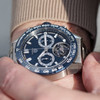

How TAG Heuer made the most affordable Tourbillon
Originally, it was supposed to be just a quick post on Instagram, but then I realized that I wanted to write more than would fit there. In 2015, TAG Heuer presented the concept of its first ever Tourbillon at Baselworld, which impressed with a price tag of €15,000.

The following year, we were already holding watches in our hands in Basel. Before I get to the Tourbillon itself, I need to mention a few things that preceded it.
TAG Heuer used ETA movements, but since ETA belongs to the Swatch Group and TAG Heuer belongs to LVMH, the Swatch Group began to reduce the export of movements outside its group, TAG Heuer had to enter into a partnership with Sellita movements in order to cover production (Sellita was formerly a partner of ETA). Therefore, we could never tell the customer exactly whether it was a Caliber 5 ETA 2824-2 or a Sellita SW200-1, but we could verify it based on the serial number.
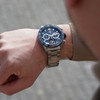
The first "in-house" movement from TAG Heuer
In 2010, TAG Heuer launched its first in-house, but not manufactured, caliber 1887. This was quite unusual, as Mr. Babin, then president of TAG Heuer, purchased the exclusive rights to the 1997 TC78 caliber platform from Seiko. This was an unusual move, as the classic method would have been for TAG Heuer to develop the movement itself, instead of "just" buying a license from Seiko and using some of its components.
No manufacturer, whether Jaeger or Patek, uses 100% of its own parts; they also have suppliers. The catch was that TAG used parts from Seiko, although the parts were manufactured in Switzerland by a company owned by Seiko.
However, it should be noted that TAG Heuer reconfigured the architecture of the movement, moved the oscillator, and modified the entire assembly according to its standards. Despite this, TAG and Mr. Babin were not entirely transparent about this collaboration. At the first press conference, not a word was said about Seiko. Later, a blogger wrote about it in an article, and all hell broke loose. Despite everything, however, I must point out that Seiko's double-sided winding mechanism was more effective and the accuracy was excellent despite the absence of COSC certification. Therefore, chronometer certification, which would only increase the price, would have been pointless.
My colleagues at Watch de Luxe and I sold a lot of the 1887 caliber, and I really don't remember ever having any problems with it or a customer refusing to buy a watch because of its connection to Seiko.
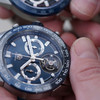
TAG Heuer's first truly in-house movement
After Jean-Claude Biver took over the management of the company, changes began to take place, and in 2015 TAG Heuer introduced its very first in-house caliber, the HEUER 01.
And now there is no doubt about the purity of its origin. The HEUER 01 was based on the 1887 movement, and all Seiko components were replaced with those from TAG Heuer (i.e., manufactured either by TAG Heuer or supplied by a Swiss supplier of Swiss origin). The new movement had to be fitted into a new case, and so the new TAG Heuer Carrera series with a modular case and skeleton dial was created.
In the same year, 2015, TAG Heuer announced the arrival of something big in the form of the Tourbillon. Although I say that making a Tourbillon is not easy, that does not mean it is impossible. If you have enough financial capital and belong to LVMH, you can do anything with watches.
However, the sensation was completely elsewhere. TAG Heuer dared to introduce a watch with a Tourbillon with a price tag (in 2016) of CHF 14,990, which was approximately EUR 15,000. This was the key point that deviated from the standard equation, as the cheapest Tourbillon from the country of the Swiss cross at that time cost approximately €27,000 from Frederique Constant and €29,000 from Jeager-LeCoultre. However, in order for TAG to embark on Breguet's complication, the legendary Haute Horlogerie department had to be created first.
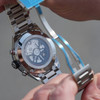
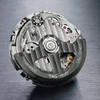
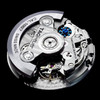
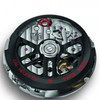
TAG Heuer Haute Horlogerie (high watchmaking)
Mikrograph: This section already had a few historical pieces under its belt, such as the ultra-powerful Mikrograph introduced in 2011, a mechanical watch capable of measuring 1/100 of a second with a Heuer 360 caliber, a reference to a pocket model from 1916. The model, priced at over €30,000, was made in rose gold (CAR5040[GS1]) and its oscillator oscillated at a frequency of 360,000 beats per hour. Therefore, there had to be two oscillators in the movement, the second one having a standard frequency of 28,800 beats per hour.
A few months later, TAG Heuer broke new ground with the Mikrotimer, a model with a mechanical movement capable of measuring 1/1000 of a second, but not only measuring it, but also displaying it on the dial, just like the Mikrograph.
Monaco V4: Another bold piece was the 2004 Monaco V4 concept model. It was a unique system in which the gear and step mechanisms were replaced by a belt drive. Several models were produced in platinum and rose gold. It was still a limited edition of only 150 pieces with a price tag of up to EUR 100,000. At the time, it was the most expensive watch in the store.
But why did TAG Heuer get into high-end watchmaking? nbsp;TAG Heuer had deep roots in the world of chronographs and did not make expensive watches until 2000, but in 2000, when a new boss took over, the Haute Horlogerie division was created and they began to focus quite a bit on haute horlogerie. Even though there was no reference to this in the past, no indication or anything else that would predestine the TAG Heuer brand to produce extremely expensive and complicated watches. HEUER was a common watch brand, just like Omega, Breitling, or Blancpain, and they never made complicated watches for the rich. Nevertheless, the HH division was created.
The fundamental problem I perceived was whether I, as a potential customer, wanted to pay the amount for which I could buy a perpetual calendar or minute repeater from Audemars Piguet for a model from TAG Heuer. Admittedly, it was a special model, but still a model from a brand where the average price was around EUR 4,000.
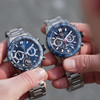
TAG Heuer, Tourbillon, and Jean-Claude Biver – the circle is complete
The whole perception of this issue changed with the arrival of a new CEO named Jean-Claude Biver (hereinafter referred to as JCB), considered by many to be a madman, but for me one of the most important figures in modern watchmaking (I am preparing a separate article about him).
JCB took over the company from Jean-Christopher Babin, who was at TAG Heuer from 2000 to 2014, and during his tenure, the legendary Grand Carrera was created – I hope it will return soon, along with the Haute Horlogerie department, caliber 1887, Indy 500, and much more.
JCB decided to take a radical step and shut down the Haute Horlogerie division. I assume he had the reason I mentioned above and because he didn't like Babina, thus creating space for a future merger between the world of HH and ordinary, more affordable models.
The first project of the new management was to be the aforementioned Tourbillon. So JCB sat down with chief designer and head of the product department Guy Semon (a former designer of military flight simulators in France) and created the new Heuer 02 T manufacture caliber.
There were 5,000 pieces of the CH80 manufacture caliber, originally called CH1969/CH1888, in stock, on which TAG Heuer had been working in its newly opened workshop in Chevenez, reportedly investing over CHF 40 million.
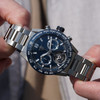
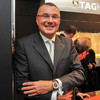
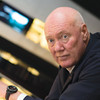
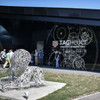
The new management at TAG Heuer decided to take 1,000 pieces of this CH80 movement and, with the capabilities of the HH department, created the HEUER 02T Tourbillon. It is said that the CH80 project was to be completely destroyed under JCB's leadership, along with all the movements. However, Guy allegedly had the idea to transform the CH80 into the HEUER 02T. But that was the movement, Guy is just cool. Not only was it much thinner and more accurate than, for example, the HEUER 01, it was also much stronger, allowing for the integration of the Tourbillon without the movement having to be thick and bulky.
So if the Tourbillon reflected a new wind in the company, it had to be set in the new skeletonized Carrera case, introduced together with the HEUER 01 in 2015. For this reason, JCB was able to save a considerable amount of money from researching and developing a completely new case and movement.
You may think that I have unnecessarily gotten carried away with a lot of text and embellishments, but it is very important for me to show that, for example, the journey to a manufactured caliber took TAG Heuer almost 155 years. It did not happen overnight or even from one year to the next. It took an enormous amount of effort, human capital, and financial resources. And all this with the constant fear that it might not succeed at all.

I will return to this topic in a future article about Jean-Claude Biver, because there is much more to his work at TH than I could possibly publish. So I will try to cover at least a little bit.
Check out this limited edition of 250 pieces with Tourbillon in our e-shop.
Introduction
My name is Martin Demko, and I have been working with watches since 2011. During that time, I have handled many models: cheap ones, expensive ones, models from renowned brands, and those from lesser-known brands. My work is both a pleasure and a hobby for me. What I have always strived for and continue to strive for is maximum honesty towards customers, even at the expense of business. I have completed numerous training courses and a relatively large number of training sessions in Switzerland. If you like my articles and my subjective view on individual topics, or if you disagree, feel free to write to me at m.demko@wdl.sk. I would really appreciate any feedback.



